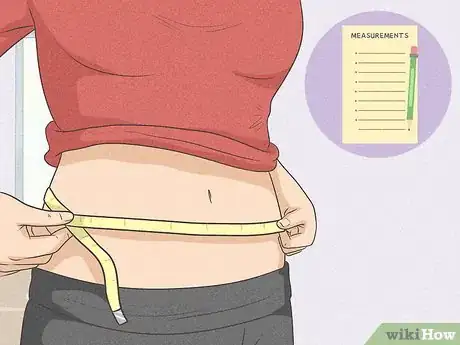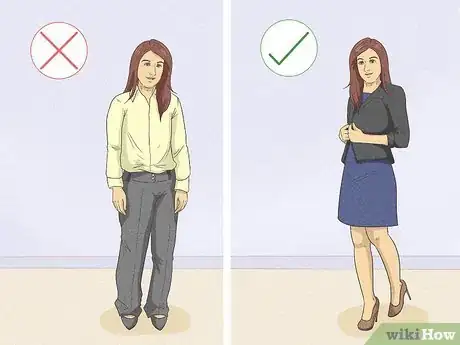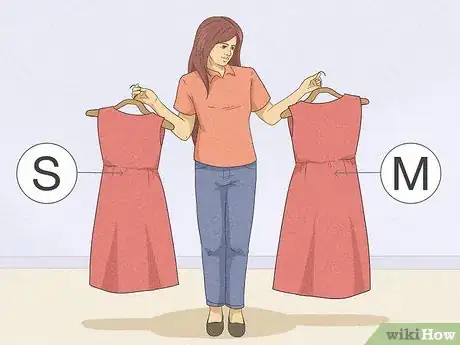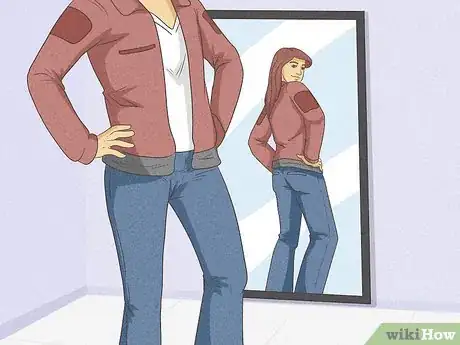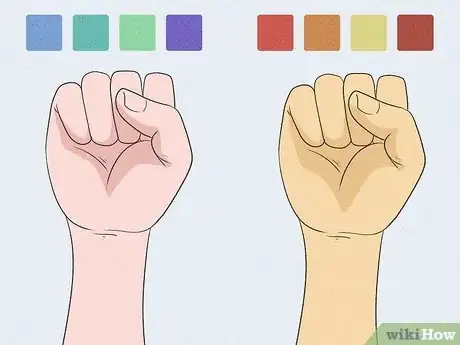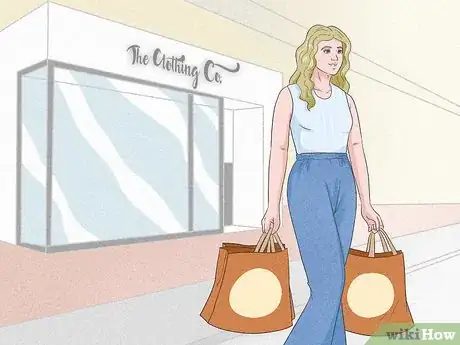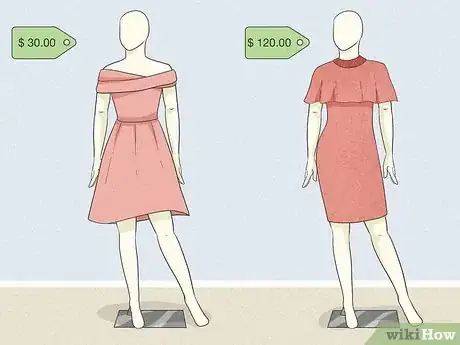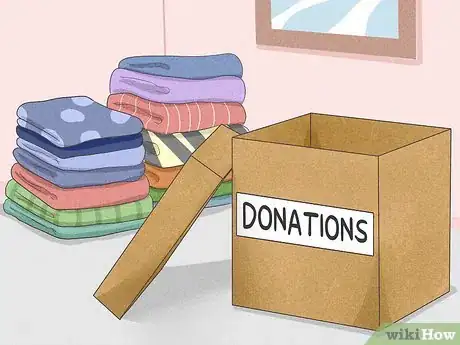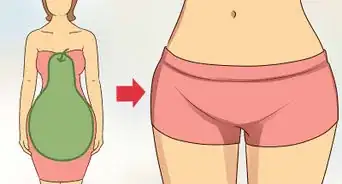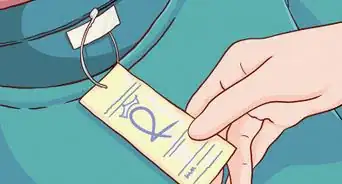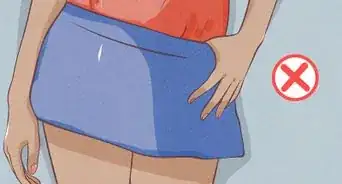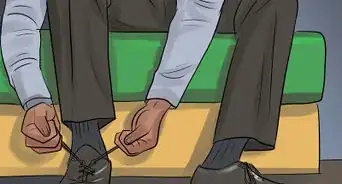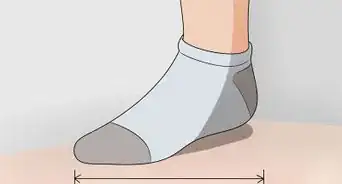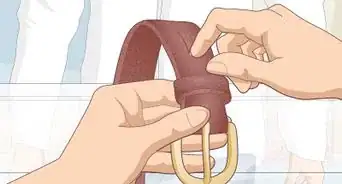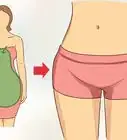This article was co-authored by Catherine Joubert. Catherine Joubert is a personal stylist who works with a wide range of clients on refining their style. She launched Joubert Styling in 2012 and has since been featured on Buzzfeed and styled celebrities such as Perez Hilton, Angie Everhart, Tony Cavalero, Roy Choi and Kellan Lutz.
There are 10 references cited in this article, which can be found at the bottom of the page.
This article has been viewed 601,524 times.
Going clothes shopping can be difficult and confusing. Sometimes you head to a department store with an idea in mind, but once you get there you have no idea where to start. There are so many different styles, cuts, sizes, colors and brands that you may feel overwhelmed. Having an idea of what looks good on you will make choosing good clothes much easier.
Steps
Dressing for Your Figure
-
1Decide which features you would like to emphasize. You can use outfits to make aspects of your appearance look bigger, smaller, more obvious, or less noticeable.[1] [2]
- Patterns – Clothes with vertical lines will usually make the part of the body they're worn on look thinner. Meanwhile, horizontal stripes will often make that space look wider. Bright, attention grabbing patterns will draw the eye to where they're worn, so if you'd like to emphasize your bust, a patterned shirt is a good strategy. The converse is also true; dark, solid pieces can de-emphasize certain areas of your body, especially when paired with bright patterns.
- Waist styles – Low-waisted paints can make your body look curvier with a more well-defined waist. Empire waists can help to emphasize your bust.
- Structured tailoring – Clothing with structured tailoring can be used to emphasize and give shape to any part of your body. Boxy outerwear can make your upper body look bulkier, while shoulder pads can specifically make your shoulders appear wider. Pleated trousers can also make legs look thicker.
- Types of hemlines – A-line skirts are great for adding curves and making your bottom half look wider. Straight skirts are also good for doing the latter. Tapered skirts have the opposite effect; wear these when trying to de-emphasize your lower body.
- Fit – In general, baggy clothing will hide definition, while tighter fits will accentuate it.
EXPERT TIPCatherine Joubert is a personal stylist who works with a wide range of clients on refining their style. She launched Joubert Styling in 2012 and has since been featured on Buzzfeed and styled celebrities such as Perez Hilton, Angie Everhart, Tony Cavalero, Roy Choi and Kellan Lutz.Professional Stylist
 Catherine Joubert
Catherine Joubert
Professional StylistResearch your body type online to find styles that will look best on you. Personal stylist Catherine Joubert says: "When you look at your body in the mirror, be honest with yourself about what you see. For instance, if you have narrow shoulders and wider hips, you're a pear shape. Then, search online and look for clothing that will help you emphasize your best features."
-
2Know your measurements. Whether you're buying clothing off-the-rack or having it tailored, it's best to keep your exact proportions in mind. Use a tape measure and write down the exact numbers. Here are the measurements you should take:[3]
- Circumference of your head for hat sizing.
- Upper arm for sleeves.
- Neck, which is more important in men's clothing.
- Widest or fullest part of your chest or bust.
- Natural waistline.
- Hips for women's clothing.
- Inseam, which is the distance from your groin to the bottom of your ankle.
Advertisement -
3Make sure your clothing fits. The right fit is the most important part of choosing good clothes. In general, a garment that fits well but is in an unflattering style will look better than a piece with a poor fit in a style meant to flatter your body shape.[4]
- Clothing that fits should be comfortable and not hinder your movements while not looking too baggy or sloppy.
- If you're planning on losing weight, don't buy clothes that you assume you'll fit into in a few months. Instead, hold off major purchases until after you make any major changes.
- Be sure to always hem your pants, especially if you're on the short side. A too-low hem will make you look much shorter.
-
4Buy clothing that looks great on you now. If a garment doesn't quite fit now but you think it'll look great once you get in shape for the summer? It's not a good idea to buy it. Shop for your current figure, not the one you think you should have. You don't want to waste money on clothes you might never wear.
- If a jacket or blazer won't button all the way, it doesn't fit. Try one size up or pick a different one altogether.
- If you're swamped in a piece of clothing, it doesn't fit. If it hangs off of you, you should pick a different size.
-
5Check how clothing looks from behind. This step is crucial in finding flattering clothes that a lot of people skip. A dress or a suit can look like a perfect fit from the front but terrible from behind.
- If you have a phone with a front-facing camera, take it with you to the dressing room to check how the back of each garment looks on you. See if it looks baggy or too tight. Make sure that it is flattering on you, meaning it's not hugging the wrong curves and that it isn't showing anything it shouldn't.
- After you check how your potential new garment looks on you from the front, turn around so that your back faces the fitting room mirror. Switch your phone to its front-facing camera mode and hold it in front of you, higher than your shoulder and tilted down slightly. You should be able to see your back's reflection in your phone's screen.
- If your phone doesn't have a front-facing camera, bring a small hand or compact mirror when you go shopping instead.
-
6Don't always follow fashion trends. You may want to keep up with new styles, but if a certain popular look is unflattering on you, don't wear it. Develop your own style and only incorporate trends that fit it well.[5]
- For example, if you're a skinny guy and ultra-baggy suits are in, don't waste money on this trend. You aren't likely to pull it off as well as other body types.
- On the other hand, if you're pear-shaped and bulky scarves are trendy, take advantage of the chance to look extra chic.
Picking out the Right Garments
-
1Find colors that work for you. These can be colors that flatter your skin tone, look great together, or are simply your favorites.[6]
- Choose clothes that match your skin's undertones. People with warm undertones tend to look better with warm colors, while cool colors pair best with cool-toned skin.
- Make outfits that incorporate complementary colors. These are colors that are opposite each other on the color wheel: purple with yellow, blue with orange, and red with green.
- Try to build a wardrobe that includes staples of only one or two neutral colors. Neutrals will make up the foundation of most outfits but don't often look good together. For clothes, these neutrals are considered to be light and dark gray, light and dark brown, navy, and black.[7]
- Remember that you should wear what makes you happiest. If you have a favorite color that doesn't match your skin tone, then it still "works" for you.
-
2Stick with a brand that you like. If you find an item that looks especially great on you right off-the-rack, check out other clothes by the same brand. You're more likely to find something else that looks great on you. While sizes and cuts are often inconsistent between brands, many brands keep their particular sizing the same over time.[8]
- At the same time, if you find a brand's quality going downhill or if it changes its sizing, start looking elsewhere.
- Keep in mind that American brands are typically more boxy and baggy compared to European ones.[9]
-
3Buy multiple versions of clothing that you like. It's not uncommon for people to buy a few different versions of a particularly great piece. This will let you spice up your wardrobe while sticking with what you know works.[10]
- For workhorses like skirts and pants, consider buying even a couple identical pieces.
- This is an especially good idea if you have a lot of difficulty finding comfortable clothing that fits.
-
4Pay attention to each item's value. If you can afford to purchase well-made, quality items now, you'll save money in the long run. For example, if a good pair of boots costs twice as much but lasts ten times as long, you'll end up spending much more money over time on ten pairs of cheap boots.[11]
- While expensive doesn't always equal well-made, well-made clothes are usually more expensive than poorly-made ones.
- With the exception of breathable summer clothes, a good sign of quality is whether or not a garment is lined.
- Check the seams before you buy. Make sure they're even and consistent. Poorly-stitched seams are a sign of poor quality.
- Go for quality over quantity. It's usually better to have a smaller wardrobe made up of well-made clothing than a larger one full of cheap pieces.
- If you're on a budget, don't forget to check online auctions and second-hand shops. You can often find what you're looking for at a fraction of the retail price.
Building Your Wardrobe
-
1Cover the basics. When picking out pieces, make sure you have solid pieces that you can wear in a variety of scenarios. You want a wardrobe that will take you from work to out to dinner without having too many pieces that are only for one type of occasion.[12]
- For instance, a nice pair of pants that fits will can be made professional with a nice jacket and a blouse. For slightly dressier dinner, take off the jacket and add a scarf.
- As another example, a knee length skirt in a solid color is appropriate for work with a solid color on top, but it could also work for brunch with friends if you add few accessories.
-
2Pick one or two neutral colors for your workhorse pieces. When it comes to fashion, the basic neutral colors are black, navy blue, browns, grays, and tans. Because neutrals don't tend to go well together in the same outfit, picking and sticking to one or two will help you create more outfits with less pieces.[13]
- Buy versatile items like skirts, pants, belts, and coats in your chosen neutral(s).
- White is also technically a neutral color, but it can be paired with other neutrals.
-
3Shop with your current wardrobe in mind. Unless you're buying complete outfits at the same time, never buy a piece unless you know what you'll wear it with. Before buying an item, mentally create one or more outfits using it and pieces you already own.
- Even though you love an item, it just may never fit into your wardrobe if it's not your usual style, which means you won't wear it.
- Skipping this step can lead to a lot of unworn pieces that just sit in your closet.
-
4Get rid of anything you don't wear. The first step of building a wardrobe isn't buying anything; it's streamlining what you already have. Go through your closet and look for pieces you never wear. Eliminating these will make choosing good clothes much easier.
- You can sell your old clothes online, if you're short on cash.
- Another option is to give them to charity. You'll even get a credit on your taxes for the donation, if you get a receipt. Some charities will pick up donations, so you don't have to go anywhere.
- Consider posting them on social media. Many times, your friends will want to claim items you don't want.
Expert Q&A
-
QuestionWhat clothing items should you splurge on?
 Natalie TincherNatalie Tincher is the Owner and Principal Style Strategist of BU Style. With more than 10 years of experience, Natalie specializes in personal styling to reflect clients’ individuality, confidence, and comfort. In 2019, she was named the Global Head of Styling for Bloomberg Television. Natalie is certified in Image Consulting through the Fashion Institute of Technology. She regularly shares her expertise with corporate groups at major financial institutions, media companies, and news outlets including: Time Out New York, Refinery 29, and NBC News.
Natalie TincherNatalie Tincher is the Owner and Principal Style Strategist of BU Style. With more than 10 years of experience, Natalie specializes in personal styling to reflect clients’ individuality, confidence, and comfort. In 2019, she was named the Global Head of Styling for Bloomberg Television. Natalie is certified in Image Consulting through the Fashion Institute of Technology. She regularly shares her expertise with corporate groups at major financial institutions, media companies, and news outlets including: Time Out New York, Refinery 29, and NBC News.
Style Strategist & Wardrobe Specialist
-
QuestionWhat should I wear if I am fat?
 Community AnswerJust wear what you look and feel great in. If you feel you are heavier, then wearing vertical striped clothing or darker clothing will help. Love yourself.
Community AnswerJust wear what you look and feel great in. If you feel you are heavier, then wearing vertical striped clothing or darker clothing will help. Love yourself. -
QuestionCan I wear a skirt for picture day if I am on my period and my knees are a bit brown?
 Community AnswerSure. Just know to always be comfortable when you're on your period. You don't want to wear something short and feel uncomfortable.
Community AnswerSure. Just know to always be comfortable when you're on your period. You don't want to wear something short and feel uncomfortable.
References
- ↑ http://www.complex.com/style/2015/04/how-to-dress-for-your-body-type-men/understand-how-clothes-affect-your-body
- ↑ http://www.fashionbeans.com/2015/how-to-dress-for-your-body-shape/
- ↑ http://www.sizeguide.net/measure-your-size-men-clothing.html
- ↑ http://www.besthealthmag.ca/best-looks/style/heres-how-to-choose-clothes-that-fit/
- ↑ http://www.besthealthmag.ca/best-looks/style/heres-how-to-choose-clothes-that-fit/
- ↑ http://www.thefashionspot.com/style-trends/177555-color-theory-learn-which-colors-look-best-your-skin-tone/
- ↑ http://www.puttingmetogether.com/2013/01/wardrobe-from-scratch-part-2-choosing.html
- ↑ http://www.besthealthmag.ca/best-looks/style/heres-how-to-choose-clothes-that-fit/
- ↑ http://www.mrporter.com/journal/dress-code/how-to-dress-your-body-type/500
- ↑ http://www.moneycrashers.com/mens-fashion-tips-how-to-shop-mens-clothing/
- ↑ http://www.moneycrashers.com/how-to-buy-quality-clothing/
- ↑ http://www.puttingmetogether.com/2012/02/building-remixable-wardrobe-part-2.html
- ↑ http://www.puttingmetogether.com/2013/01/wardrobe-from-scratch-part-2-choosing.html
About This Article
Choosing good clothes can be tough, but you’ll find it a lot easier if you put together a good wardrobe. Choose a few items you can easily mix and match, such as jeans, skirts, and tops. That way, you'll find it easier to dress up for work or dinner, or throw on a more relaxed outfit. You should also look for several things in neutral colors, like black, dark blue, or white, since these colors are easier to work into an outfit. The clothes you choose should not be too large or too tight, because you'll always feel better when you wear things that fit you properly. For tips from our Fashion co-author on how to build your wardrobe, keep reading!

